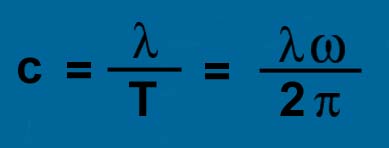| Malin's Magnificent Math |
|
Home
Scaling & Shifting of Graphs Elementary Waves Affine Functions Waves in 2D & 3D |
Elementary Waves (as functions in 1D)i.) Basic Parameters: λ , ω, T, c and AWhat is a wave?A wave is a transfer of enery, in the form of a disturbance through some medium, without translocation of the medium. In other words the individual parts of the medium return to their original state and position after the wave has passed. Light is an example of a transverse wave traveling in an electromagnetic medium. In a transverse wave the wave moves in a direction perpendicular to the motion of the medium.Light waves vibrate in repeating cycles and thus, are examples
of periodic motion (or harmonic motion). A cosine or sine function
can be used to represent a light wave.
What are the basic parameters that are used to define waves?Wavelength: It is represented by the greek letter lambda, λ. The wavelength is the spacial distance between two crests of the wave.Frequency: Is the number of cycles per second. Radial Frequency: It is represented by the greek letter omega, ω. Radial frequency is the number of radians (π) the wave travels per second. The units for radial frequency is radians per second. Period: Is the time it takes to go through one cycle at a fixed point. The letter T is used to represent the period. Velocity of Light: Velocity at which the crests travel. The speed of the wave and the direction it is travelling in. The letter c is used to represent the velocity of light. Amplitude: The amplitude is a measure of how big the wave is. It is measured as the distance from the equilibrium point to the highest point of a crest or to the lowest point of a trough. The letter A is used to represent the amplitude. Here is a diagram illustrating the parameters that can be shown on the graph of a wave
ii.) Fundamental EquationThe fundamental equation shows the relationship between the velocity of the light c, the wavelength λ, and the radial frequency ω or the period T.
iii.) Wave Equation (in 1D)The cosine or sine functions are used to represent the equation of a wave.The equation of a wave is: 
Or another way of writing the equation of a wave using the variable ω is: 
The resulting graph of the wave is dependent on the different parameters (A, λ, ω and t) found in the wave equation. The following show how changes in these parameters affect the graph of the wave. (These changes demonstrate the scaling and shifting of graphs from Section A.) Changing the amplitude:If the amplitude changes this causes the graph to stretch or shrink vertically by a factor of A.Changing ωt:If the equation starts at a time other than zero or ω is changed this results in the shifting of the graph right by ωt.Changing the wavelength, λ:If the wavelength is changed from 2π this causes the graph to stretch or shrink horizontally by a factor of λ |